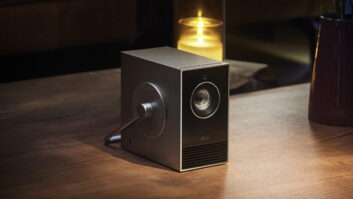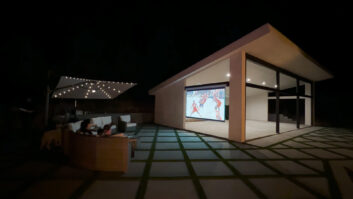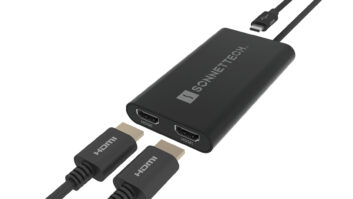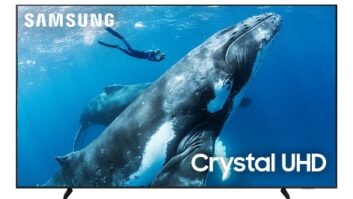What to Consider Before Designing a Reliable 4K Video Distribution SYSTEM

Four-K Ultra HD is capable of delivering stunning beauty and resolution. But like most new technologies, it comes with challenges to overcome. There are a few unique attributes that must be considered to succeed in designing reliable, high-quality 4K video distribution systems.
What’s Your Throughput?
4K video represents the state-of-the-art in image resolution and quality. Even 1080p signals seem much more stunning on these new UHD displays. Delivering that incredible detail and image quality at 4K resolution, however, greatly impacts distribution systems. The increase in resolution is also an increase in the demand for data. A single frame of 4K video is composed of nearly 8.3 million pixels, compared with about 2 million pixels for a single frame at 1080. All of that data requires enormous transfer rates (~10 Gbit/s) which places unprecedented demands on infrastructure.
This explains the trend toward and demand for greater data rate capabilities. This trend will, no doubt, continue in the future with ever-higher resolutions on the horizon. So, when designing a distribution system, it’s essential to make sure the infrastructure can reliably deliver 4K content without data loss that can and will compromise image quality or prevent the signal from being displayed, outright.
When it comes to the transport technology for 4K distribution, HDBaseT® is the method of choice, and you want to make sure that your cable infrastructure includes these two simple but critical capabilities:
1) The cable is proven to deliver 4K video with less than one error per billion pixels transmitted over the distance of your cable run
2) The cable complies with standards set forth by EIA/TIA–those for CAT6 or CAT7a, for example–so that any future transport technology is likely to be well supported
These transmission requirements apply not only to the cabling infrastructure, but also the electronics. Every transmitter, switcher, extender, AVR, surround sound processor, and receiver between the source and the display must be capable of handling 4K resolution. A single device that is unable to meet the demands that 4K places on the system creates a bottleneck that will block the 4K signal.
The technology behind 4K/Ultra HD is capable of delivering stunning beauty and resolution, like these TVs at Panasonic’s (top) Samsung’s (bottom) 2014 CES exhibit. But like most new technologies, it comes with challenges to overcome, especially when distributing the signal around a house. Mixing 4K with Standard HD


You may find yourself asking “What if some of my displays aren’t being upgraded to 4K? Can my 4K and 1080p devices play well together? Can I partially upgrade a system?” In practice, we’re likely to see a mixture of HD and 4K components in integrated systems for some time to come.
Just like the transition from SD to HD, during which we had systems comprised of blended components, it’s inevitable that HD displays will remain part of video distribution systems. There are several reasons for this: HD displays might already be in place; they have a more budget-friendly price point (though that seems to be changing rapidly, as exhibited by 2014 Black Friday. Wow!); some applications require smaller display sizes that are currently only available in HD; and specialty displays such as streaming outputs and touch screens are still predominantly HD. But clients will expect that all of their sources, including their new 4K sources, will be viewable on all displays whether 4K or not. It’s difficult to tell a client that they can only watch that source on that one 4K display.
Scalers, which can convert one video timing to another, have proven to be critical components of video distribution systems for years. They’ve added the features of instant switching, eliminated flickering and the “no source” messages on displays during switching, made video walls out of ordinary televisions, and ensured that even old SD sources look their best on HD displays. In a 4K distribution system, however, the most important application of scaling is likely to be the downscaling of 4K video so it can be shown on 1080p displays.
Interoperability
It’s easy to make assumptions based on years of experience with SD and HD systems that simply don’t hold true in the 4K landscape. For example, when specifying a set of 4K sources and displays it may seem logical to assume that they can all interoperate in an integrated system. However, it may not be true if the sources and displays have not been certified by a reliable testing program.
In 2009, HDMI distribution systems were on the “bleeding edge” of technology, and their designers knew it. That’s because it was easy to see that HDMI® is more complex than component video, and we took the time to learn about those changes. Today, 4K is the bleeding edge, but it’s not as apparent because of its commonalities with the HDMI we already know ? or think we know.
Despite the familiar connector and cable, there are real interoperability problems out there between 4K sources and displays. You might install a complete 4K distribution system, carefully ensuring that your infrastructure and electronics all provide the necessary throughput, only to find that you don’t have a picture when you route your first source to a display. There are many possible reasons for this, of course, but the most important one to understand is this: the HDMI Compliance Test Specification (CTS) does not require full testing at 4K resolutions. Unless the sources and displays in your system have been tested and issued 4K certification by a reputable organization, there’s no guarantee that those devices are up to the challenge of reliably performing their role in a distributed AV system.
Education
This article is meant to be a primer on some of the most important facets of 4K distribution system design. But the challenges and potential pitfalls are too numerous and complex to be learned from a simple article. Therefore, it’s imperative that you become expert in the unique design considerations and challenges of 4K distributed systems by taking 4K certification courses from a leading training provider. Manufacturers invest in developing these training programs because they want the installations in their customers’ homes to be successful the first time. That’s why you should make a similar investment in attending these courses. Education is critical to success, so get out there and learn. As you may remember from Schoolhouse Rock! “It’s great to learn, because knowledge is power!”
The many possible combinations of sources and displays present challenges in designing a switched 4K distribution system. As a system designer or integrator, you must carefully consider the systems you’re assembling to provide a good customer experience. Before designing a 4K distribution system, it’s essential to educate yourself on the complexities of this exciting new resolution, identify limitations and desired capabilities, and components you can rely on. Only by meeting and passing a rigorous 4K certification program should a source or display earn its place in the 4K distribution systems you design.
Kevin Iselli is senior curriculum developer at Crestron Electronics. He is responsible for the creation and continuing development of all DigitalMedia classes.
A Certified End-to-End Solution is a Possibility
Distributing 4K takes much more than a matrix frame. It takes inputs, outputs, transmitters, and receivers all engineered to work together as a complete system. With DigitalMedia 3.0, Crestron is now shipping an end-to-end 4K certified distribution solution, with all of the components needed to build a complete 4K system, or upgrade an existing one to.
Crestron’s system includes DM 4K Switching, a full range of switchers, transmitters, receivers, and all-in-one presentation systems; DM-RMC-4K-SCALER-C, which will take any resolution in and convert it to any resolution (up to 4096×2160 at 60 Hz); and DM Ultra Cable, which was designed to deliver error-free 4K HDMI signals via HDBaseT over longer distances.
Under the company’s 4K Certification program, third-party 4K sources and displays are tested for reliable performance in a DM environment. Additionally, the Crestron Training Institute is providing industry professionals with advanced courses that focus on the unique system design considerations of 4K to ensure reliable operation.
–KI







